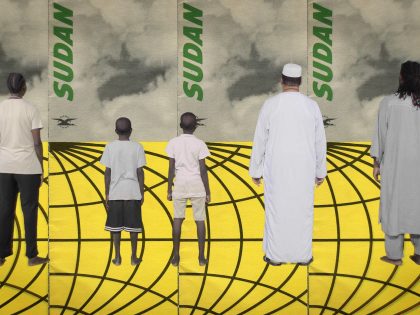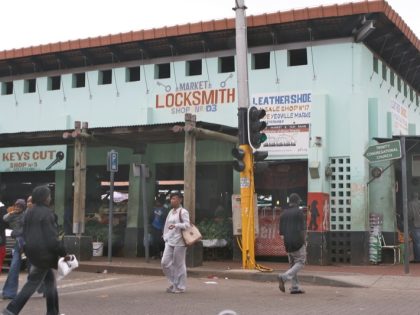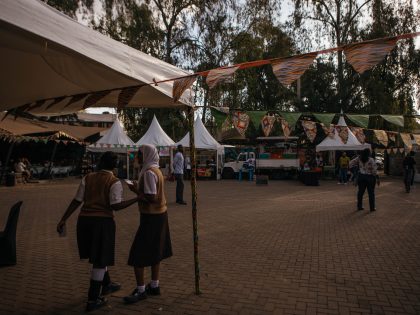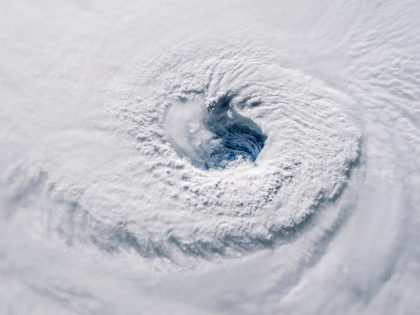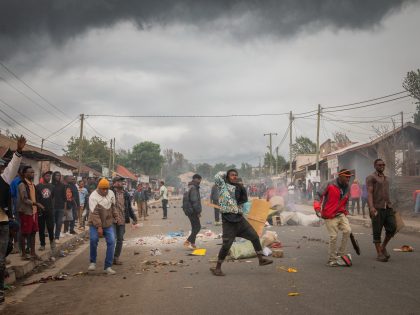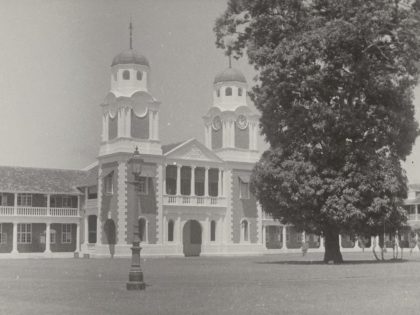African poets get their own documentary
The friendship of the poets Syl Cheney-Coker and Niyi Osundare is the subject of the road movie documentary, "The Poets."

The poets and longtime friends, Syl Cheney-Coker (left) and Niyi Osundare, drink their friendship.
The documentary film, The Poets, ends with its two protagonists, poets Syl Cheney-Coker and Niyi Osundare, sitting on a balcony at Osundare’s home in Ibadan, Nigeria with a tumbler of whisky in their hands. They toast to literature and poetry, to their long friendship, to their dynamic past and their futures. With their backs to us, they look out ahead as the pouring rain beats down upon a half-constructed building but keep turning around to recount something or the other. This retrospective positioning—looking ahead but simultaneously gazing back—is the precise mode of this literary documentary.
The film, directed by Chivas DeVinck, is a beautifully shot, spontaneous and lyrical journey down memory lane in the most literal sense possible. Director DeVinck brings together two prolific poets from West Africa and sends them off on nostalgic trips in their respective countries; Freetown for Cheney-Coker and Ikeri-Ekiti and Ibadan for Osundare. The documentary’s structure is deceptively straightforward and very well thought out. Symmetrically divided into two with the first half of the journey unfolding in Sierra Leone with Cheney-Coker as the interlocutor and then the second half with Osundare taking us through several parts of Nigeria, The Poets makes very particular, decisive stops.
Borrowing from the structure of a Künstlerroman, the type of novel that explores an artist’s formative years and eventual coming to maturity, the documentary forces the two poets to return to their childhood homes, their schools and their universities. Along the way, impactful political traumas are also explored with short bursts of archival footage; the Sierra Leonian civil war, military rule in Nigeria and Hurricane Katrina are some of the examples. Not to be forgotten is the true protagonist of this documentary: poetry. Ever so frequently, both poets read evocatively as the camera pans across various related and unrelated imagery. The poems are simultaneously inscribed in the poets’ own handwritings onto the screen thus making this documentary a richly layered, intertextual and intermedial experience.
The filming begins in the cramped, intimate space of a car as it navigates the busy Freetown streets. Cheney-Coker is the dynamic, informative guide and Osundare is a teasing, affectionate and curious tourist. The tone is immediately jolly and infectious: here are two avuncular guys brimming with anecdotes ranging from serious to completely facile, needling each other but also learning from each other. As they make their way through the city, Cheney-Coker points out how the war in Sierra Leone has marked everything. Wide, panoramic shots of the densely populated and hilly city along with Cheney-Coker’s intimate memories of the space allow Osundare and the viewer to have an affective experience of the geography.
The next section takes us to Cheney-Coker’s childhood home built in 1936 which he has reclaimed since the end of the war. Books abound in the modest, crumbling interiors and soon, a visit to his school rounds out the importance of a truly literary education. The camera eventually turns its attention upon the sea. With the views of the Atlantic ocean, comes slavery’s omnipresent haunting. “If there was no ocean, there would be no Syl Cheney-Coker’s poetry,” Cheney-Coker explains. DeVinck gives us our first beautifully choreographed poem sequence as Cheney-Coker reads one of his well-known poems called “The Breast of the Sea” as a boat glides over gentle, sun-sparkled waves. The music sets the tone for a grim memorializing of “our bloody century” and the orphans, pain, tears and suffering it has left behind.
The film successfully seals the connection between place and poetry, and it is through reciting particular poems in carefully chosen public and intimate spaces that allow for evocations about history and humanity to emerge. The history of slavery in West Africa, the history of war, the centrality of the sea as ethos and identity as well as personal reflections on marriage and love are folded into the fabric of these sequences. An incisive montage also takes the audience through Sierra Leone’s brutal history of mining. “Shameless stone, bloodletting woman, I could have loved you, but I give you up for the feverish lust of the world!” Integral to several of these poems is the politics of Africa’s colonial history and its resounding, almost incalculable impact upon the present.
Without much warning, we are suddenly in the car again, this time in a traffic jam in Lagos. Osundare becomes the poet-guide taking us through Yoruba country. Familiar tropes and themes come and go—visits to schools and universities, the formative years in childhood homes and the profound importance of education. But Osundare’s Nigeria is more ceremonial and bustling. Several friends and family members crowd around into the camera. The welcome rituals are grander and longer. There is an international poetry festival where Osundare is shown as a revered and honored member of the community. We learn that just like the Sierra Leone war for Cheney-Coker, Hurricane Katrina figures as the psychic wound in Osundare’s life.
Our two poets turn into flanêurs as they make their way through a crowded marketplace brimming over with colorful produce. The serious and the banal, the traumatic and the carnivalesque, and the political and the frivolous are perfectly at peace in this film, and scenes such as the one in the marketplace are evidence of that.
In the second half of the documentary, there is a real deepening around the conversations about poetic form and political poetry, the debate on African languages, the literary canon inherited from colonialism and the many problems that plague their beloved continent. We are in Nigeria, so the poets are predictably perturbed by how to combat corruption and also poor governance in several African countries. The Poets is an impressive homage to storytelling. Tales weave and wind through the documentary, always engaging, delightful, and emotionally and intellectually rich. It is evident that poets are completely committed to and deeply steeped in traditions of orality and the act of recounting stories and reciting poems.
The poets also engage with the fraught relationship between poetic form and political engagement, a tension that remains at the core of Western understandings of poetry and literature, and one that they have clearly inherited from years of being marinated in what passes as canonical and classical. “All literature is protest literature, in some form or another,” declares Osundare. “The most sublime form of art is the protest against silence. The real issue is what or whose politics. You know, I’ve been called a political poet. There was a time I used to be concerned about it. Now I claim it as Christians who say, “and I embrace this.” Oh yes, it’s political! Why not political? My very presence on this earth is political. My existence as a black person is political. The language I use itself is political. The choice is political.” These declarations aside, it is the documentary itself that becomes evidence of the ways that the poetic and the political are fundamentally interwoven. Not only are the poets completely imbricated in a complex and demanding socio-political sphere, their poetic practice draws from it and simultaneously nourishes it.
Films about poets are not necessarily commonplace but the poetry documentary is a fairly established minor genre especially in the past decade or so with the rise in popularity of spoken word. Within that, any engagement with African poetry is particularly rare, if not non-existent. In fact, several generations of African poetry has not gotten the attention it deserves in academic and literary spheres, and The Poets reclaims and revives that space, and makes it pulse with life and potential.
At the end of documentary, the toast soon turns into a conversation with the film’s director and Osundare asks the question that the audience has been wondering for the past hour and a half. “Why did he chose us two out of the pantheon of African literature?” It is certainly a curious choice but manages to whet the appetite for a series-like project. Perhaps two East African poets will be the subject of DeVinck’s next film. The film fades to credits and the questions, hopes and poems continue to hang in the air.












